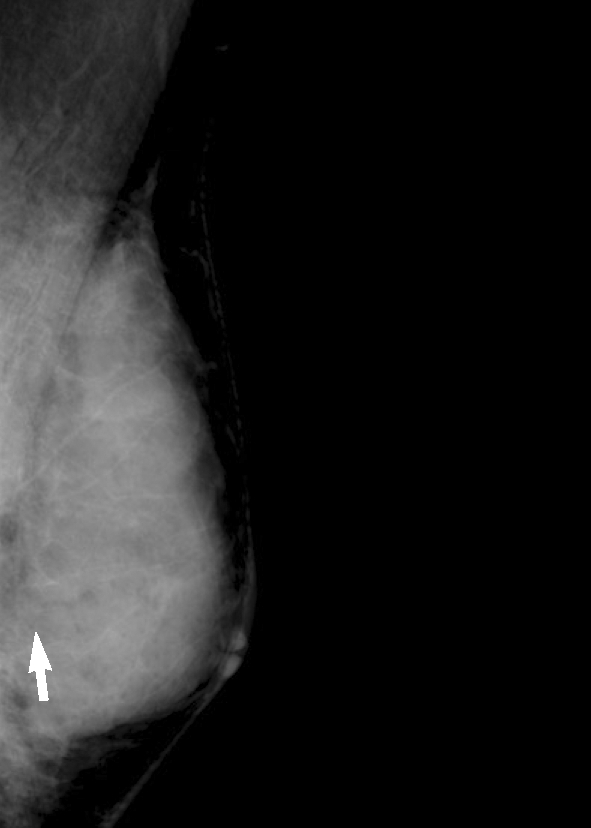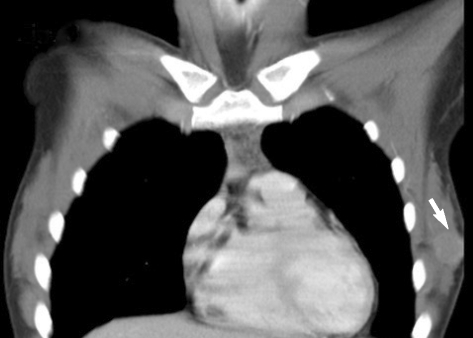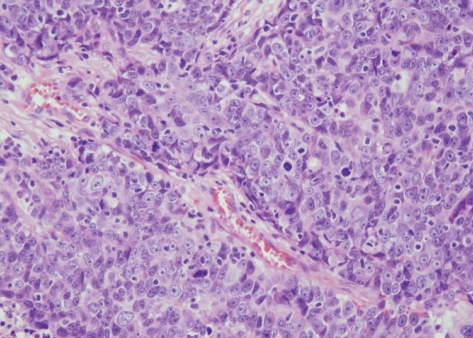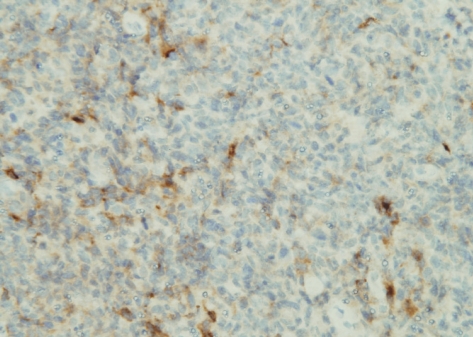Abstract
Some breast neoplasms are classified as primary neuroendocrine carcinomas because they are positive for neuroendocrine markers. Although neuroendocrine carcinomas can originate from various organs of the body, primary neuroendocrine carcinomas of the breast are extremely rare. The diagnosis of primary neuroendocrine carcinoma of the breast can only be made if nonmammary sites are confidently excluded or if an in situ component can be found. Here we report a primary large-cell neuroendocrine carcinoma (LCNL) involving the left breast. Breast ultrasonography revealed a lobulated, heterogeneous, low-echoic mass in the left breast, and the lesion ap-peared as a well-defined, highly-enhancing mass on a chest computed tomography scan. Ultrasound-guided core needle biopsy was performed on the mass, and primary LCNC was confirmed by histopathologic examination.
Keywords: Breast; Ultrasonography; Tomography, X-Ray Computed; Large Cell Neuroendocrine Carcinoma
INTRODUCTION
Neuroendocrine carcinomas are malignant tumors that show histopathological and immunohistochemical evidence of neuroendocrine differentiation. Neuroendocrine carcinomas can develop at many sites of the body, but primary neuroendocrine carcinoma of the breast is very rare (1). There are different histologic subtypes of neuroendocrine carcinomas of the breast that have been reported in the literature (1-4). In 2003, the World Health Organization (WHO) recommended classification of these tumors into three histologic types: solid, small-cell, and large-cell neuroendocrine carcinoma (5). There are some reports of neuroendocrine carcinoma of the breast in the pathology literature (2, 3), but there are few reports that describe the imaging features (6, 9) and most of them are about small-cell carcinomas. To our knowledge, the radiologic appearance of primary large-cell neuroendocrine carcinoma (LCNC) of the breast has not been described previously. In this case report, we present the radiologic and pathologic findings of primary LCNC of the breast in a 27-yr-old woman.
CASE REPORT
A 27-yr-old woman presented with a palpable mass in her left breast. The mass was first noticed one year previously and it had grown substantially. She had no remarkable past medical history, no family history of breast, colon, or ovarian cancer, and was not on any medications. On physical examination, a soft, movable mass was palpated in the left breast. The lesion was located at the three o'clock position of the left breast 4 cm from the nipple. There was no axillary lymphadenopathy, skin retraction, or abnormal nipple discharge. Mammography showed a relatively well-demarcated, lobular shaped mass in the mid-outer portion of the left breast (Fig. 1). Breast ultrasonography (US) revealed a circumscribed oval, gently lobulated, heterogeneous, low-echoic mass measuring about 3.2×1.3 cm in size in the left breast (Fig. 2). The lesion was thought to be low suggestion of malignancy, BI-RADS category 4A. An ultrasound-guided 14G core needle biopsy was performed for the mass. On a chest CT scan, the lesion appeared as a well-defined, highly-enhancing mass in the left breast (Fig. 3). In the right upper lung, there was pulmonary tuberculosis lesion, but we could not find any lesions suggestive of primary lung cancer. Abdominal ultrasonography, whole body bone scan and PET CT scan were performed for preoperative metastasis work-up and no distant metastasis was found. She underwent breast-conserving surgery and left axillary lymph node dissection. On microscopic examinations (Fig. 4), small nests of large tumor cells with faintly granular cytoplasm were present and separated by dense collagen bundles. An immunohistochemical panel (Fig. 5) was performed, and the tumor was found to be positive for neuroendocrine markers (chromogranins, synaptophysin, and neuron-specific enolase [NSE]). These pathologic findings were compatible with primary LCNC.
Fig. 1.

Mammography showed a relatively well-demarcated, lobular shaped mass in the mid-outer portion of the left breast.
Fig. 2.
Breast US revealed an oval shaped, micro-lobulated, heterogeneous low-echoic mass, measuring about 3.2×1.3 cm in size, in the left breast.
Fig. 3.
Chest CT scan showed a well-defined, highly-enhancing mass in the left breast.
Fig. 4.
Photomicrograph of a histopathologic specimen showed small nests of large tumor cells with faintly granular cytoplasm separated by dense collagen bundles (Hematoxylin-eosin, magnification ×200).
Fig. 5.
The tumor stained positive for chromogranin A (magnification ×200) and also expressed neuron-specific enolase and synaptophysin (not shown).
She underwent adjuvant chemotherapy and radiation therapy. At 18 months post-operation, there was no evidence of local recurrence or distant metastasis.
DISCUSSION
More than 97% of neuroendocrine tumors occur in the gastrointerstinal or respiratory system, and primary neuroendocrine carcinoma of the breast is very rare. In a series of 1,845 histopathologically-proven breast cancer, the incidence was about 0.27% (6).
The diagnosis of primary neuroendocrine carcinoma of the breast can only be made if nonmammary sites are confidently excluded or if an in situ component can be found (9). There are different histologic subtypes of neuroendocrine carcinomas of the breast reported in the literature (2-4). Papotti et al. divided neuroendocrine carcinomas into seven histological types (A-G) (2). Sapino et al. described five different histological types: solid cohesive, alveolar, small cell, solid papillary, and cellular mucinous (3). In 2003, the World Health Organization (WHO) recommended differentiation of these tumors into three histologic types: solid, small-cell, and large-cell neuroendocrine carcinoma (5). There are some features that favor neuroendocrine differentiated carcinoma of the breast and morphologic features should be confirmed immunochemically or by positivity for neuroendocrine markers (3). NSE, chromogranin, and synaptophysin are widely accepted as neuroendocrine markers, though NSE is relatively non-specific (4). In our case, the three aforementioned neuroendocrine markers were all positive.
LCNC, one of the subtypes of the 2003 WHO classification of neuroendocrine tumors, shares common features of the neuroendocrine-differentiated tumor described above and also shows more specific cytologic features: large cell size, polygonal shape, low nuclear-cytoplasmic ratio, finely granular eosinophilic cytoplasm, occasionally prominent nucleoli, peripheral palisading, mitosis, and necrosis (8).
In a clinical setting, neuroendocrine carcinomas usually occur in women around the 7th decade; most patients in the previously reported cases were between 40 and 70 yr old (2, 4-6, 9). Our patient was a 27-yr old woman without risk factors of breast cancer and presented with a painful breast mass that had appeared about one year prior. The mass was soft and movable on physical examination. It is an uncommon presentation of breast cancer, considering the patient's age and clinical findings. The prognosis of neuroendocrine-differentiated carcinoma is a subject to debate, probably due to different growth patterns of the subtypes and the low number of cases. In some recent literature, primary neuroendocrine carcinomas of the non-small cell type have shown satisfactory prognosis with adequate surgical excision and adjuvant chemotherapy (5, 10).
Previously noted mammographic findings of neuroendocrine carcionoma included high-density round masses with spiculated or lobulated margin (6, 9). Our findings are not significantly different. US findings of our patient were those of gently lobulated, heterogenous, low-echoic mass. In one series of five neuroendocrine carcinomas, most of the lesions demonstrated homogeneous low-echoic masses, though the WHO classification was not used and all of the lesions were of the solid and papillary subtypes (6). US findings in small-cell carcinoma reported by Mariscal et al. was of a solid, homogeneous, low-echoic mass with a partially ill-defined margin and mild posterior acoustic enhancement (9). In our case, CT findings are also presented. A chest CT scan was performed as part of a metastastic work-up as well as for evaluation of pulmonary tuberculosis. The lesion appeared as a well-defined, highly-enhancing mass in the left breast.
In summary, we presented imaging findings of a LCNC of the breast. This is the first report describing imaging features of large-cell type neuroendocrine carcinoma and presenting the CT findings of a neuroendocrine-differentiated carcinoma in Korea. This is a rare entity, and description of more cases is necessary to determine the radiologic and clinical features of LCNC.
Footnotes
This study was supported by Korea University Grant.
References
- 1.Maluf HM, Koerner FC. Carcinomas of the breast with endocrine differentiation: a review. Virchows Arch. 1994;425:449–457. doi: 10.1007/BF00197547. [DOI] [PubMed] [Google Scholar]
- 2.Papotti M, Macri L, Finzi G, Capella C, Eusebi V, Bussolati G. Neuroendocrine differentiation in carcinomas of the breast: a study of 51 cases. Semin Diagn Pathol. 1989;6:174–188. [PubMed] [Google Scholar]
- 3.Sapino A, Righi L, Cassoni P, Papotti M, Pietribiasi F, Bussolati G. Expression of the neuroendocrine phenotype in carcinomas of the breast. Semin Diagn Pathol. 2000;17:127–137. [PubMed] [Google Scholar]
- 4.Zekioglu O, Erhan Y, Ciris M, Bayramoglu H. Neuroendocrine differentiated carcinomas of the breast: a distinct entity. Breast. 2003;12:251–257. doi: 10.1016/s0960-9776(03)00059-6. [DOI] [PubMed] [Google Scholar]
- 5.Tsai WC, Yu JC, Lin CK, Hsieh CT. Primary alveolar-type large cell neuroendocrine carcinoma of the breast. Breast J. 2005;11:487. doi: 10.1111/j.1075-122X.2005.00158.x. [DOI] [PubMed] [Google Scholar]
- 6.Gunhan-Bilgen I, Zekioglu O, Ustun EE, Memis A, Erhan Y. Neuroendocrine differentiated breast carcinoma: imaging features correlated with clinical and histopathological findings. Eur Radiol. 2003;13:788–793. doi: 10.1007/s00330-002-1567-z. [DOI] [PubMed] [Google Scholar]
- 7.Miremadi A, Pinder SE, Lee AH, Bell JA, Paish EC, Wencyk P, Elston CW, Nicholson RI, Blamey RW, Robertson JF, Ellis IO. Neuroendocrine differentiation and prognosis in breast adenocarcinoma. Histopathology. 2002;40:215–222. doi: 10.1046/j.1365-2559.2002.01336.x. [DOI] [PubMed] [Google Scholar]
- 8.Krivak TC, McBroom JW, Sundborg MJ, Crothers B, Parker MF. Large cell neuroendocrine cervical carcinoma: a report of two cases and review of the literature. Gynecol Oncol. 2001;82:187–191. doi: 10.1006/gyno.2001.6254. [DOI] [PubMed] [Google Scholar]
- 9.Mariscal A, Balliu E, Diaz R, Casas JD, Gallart AM. Primary oat cell carcinoma of the breast: imaging features. AJR Am J Roentgenol. 2004;183:1169–1171. doi: 10.2214/ajr.183.4.1831169. [DOI] [PubMed] [Google Scholar]
- 10.Berruti A, Saini A, Leonardo E, Cappia S, Borasio P, Dogliotti L. Management of neuroendocrine differentiated breast carcinoma. Breast. 2004;13:527–529. doi: 10.1016/j.breast.2004.06.007. [DOI] [PubMed] [Google Scholar]






